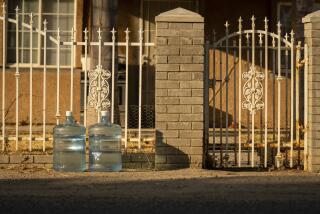Column: The next crisis for California will be the affordability of water

The price of almost everything is on the rise, but we tend to shrug off inflation in goods and services we can cut back or do without. Not water, the rising cost of which is looming as a defining economic problem in coming years.
In California and across the nation, concern about water affordability has been spreading, with good reason. Few basic commodities are under as much cost pressure.
“The water infrastructure is aging, there’s more water contamination and our standards for cleanliness keep rising, and climate change is making our supplies less reliable,” says Laura Feinstein of the Pacific Institute, an Oakland-based environmental think tank. “At some point the bill comes due” — but because water demand is stable or even dropping, water agencies can find revenue to cover the bill only by raising rates on consumption.
The result is an inexorable rise in water rates. Rates in Los Angeles rose by as much as 71% from 2010 to 2017, according to a survey by Circle of Blue, a water news website. In San Francisco the increase was as much as 127%, and 119% even for the stingiest users, a group that presumably includes many low-income residents.
Outside California, some municipalities are taking aggressive steps to bring down the cost of water for low-income residents. Philadelphia initiated the nation’s first income-based water rate on July 1. Under the program, a household earning less than 50% of the federal poverty line, or $12,300 for a family of four, will pay no more than 2% of their monthly income in water, sewer and stormwater charges. The rate rises with income; a household earning between 100% and 150% of the poverty level will pay no more than 3% of income for those services.
The water infrastructure is aging, there’s more water contamination and climate change is making our supplies less reliable. At some point the bill comes due.
— Laura Feinstein, Pacific Institute
In Atlanta, which is facing an enormous bill for infrastructure construction and maintenance, voters last year approved a four-year extension of a 1% sales tax to cover the cost, so it could be spread beyond water ratepayers alone.
Finding ways to ensure affordability is an especially acute problem in California, where water service is provided by a patchwork of more than 3,000 city, county, mutual and private agencies, some of which are too small to shoulder the burden of lifeline rates for their poorest customers. Their options are limited by Proposition 218 of 1996, which forbids charging more to higher-income municipal customers to fund rebates or subsidies for poorer residents.
Complicating the issue is that water rates are generally set locally. Proposition 218 requires that they have some relation to the cost of providing the water in the case of public agencies like the Los Angeles Department of Water and Power; the Public Utilities Commission oversees rates only for nine private water companies, which cover about 15% of the state’s residents.
But the need is growing. “We have lifeline rates for electricity, weatherization, even telephones,” says J. R. DeShazo of UCLA’s Luskin School of Public Affairs, “but we do not have a statewide program that ensures that people have affordable water.” The recent drought, he observes, “has thrown that need into relief.”
Indeed, the drought pushed the share of income devoted to water to 2.1% from 1.8% for households earning less than $25,000, according to a survey released this year by the Pacific Institute; for those earning less than $10,000, costs rose to 5.3% of income from 4.4%. “These households have little or no disposable income,” the report said, “so any increase in water costs poses a major problem.” Not only do those households have little wiggle room on spending, but they’re relatively unlikely to have options for reducing water use — they can’t cut back on lawn watering if they’re apartment dwellers, for example.
About one-third of the state’s residents, or about 13 million people, live in households with income below 200% of the federal poverty line, or $49,200 for a family of four. In some rural and agricultural communities, the percentage is well above 80%. Those are the households most vulnerable to rising rates.
State officials have committed themselves to fighting for water affordability. A state law in 2012 established as official state policy every human being’s right to “safe, clean, affordable, and accessible water” — the first such state commitment in the nation. The enactment of AB 401 followed in 2015, instructing the State Water Resources Control Board to develop a program for water rate assistance for low-income households and present it to the legislature by next Feb. 1.
Meanwhile, the PUC has become concerned about the wide variation in low-income assistance programs offered by the water companies under its jurisdiction. The PUC last month launched a rulemaking proceeding to examine them all and find ways to “ensure consistency” among them.
The fragmented structure of the state’s water delivery systems and the obstacle of Proposition 218 mean that rate relief will have to be delivered through a state program, and it will have to be a big one. “If California does enact such a program, it would be out in front,” says Max Gomberg, who is overseeing work on the options at the state water board. “No other state has done this.” The board, working with the Luskin School, has worked up several options and has aired them at a series of local hearings. The next two sessions are scheduled for Monday in Sacramento and Wednesday at Los Angeles City Hall.
The options include providing every household earning below 200% of the poverty line with a 20% discount on their water bill; giving those households tiered discounts ranging from 20% to 35%, depending on the size of their bills; or limiting the 20% discount to eligible households not yet served by private utilities with or without PUC-mandated lifeline programs. The total cost of the programs would range, in Luskin’s estimate, from $277 million to $619 million a year.
Those are all cheaper than the electricity lifeline, which costs $1.3 billion a year, or the telephone lifeline, which comes to $723 million. But it would almost certainly have to be funded by a general statewide tax. That would make the program subject to Proposition 13’s requirement of a two-thirds vote in each house of the legislature.
Another issue will be determining who among the eligible population actually pays water bills and how much. More than electricity or phone bills, water bills often are paid by landlords, who pass the costs on to tenants as part of the rent. That means the relief may have to be delivered via a straight subsidy to eligible households, based on the assumption it will help to defray their implicit water charges.
The trend in water costs over the last couple of decades indicates that the problem is bound to get worse. That’s partially because of bad choices.
“One big-picture solution is not to invest in overly expensive water sources” such as desalination, which far outstrips the cost of water recovered via conservation and recycling, the Pacific Institute’s Feinstein says. “Having to pay for a huge desalination plant that isn’t necessary will really burden low-income residents.”
Another solution is to stay on top of maintenance. Water infrastructure is deteriorating all across America and Californians know how costly the consequences can be. The break in a Department of Water and Power water main on Sunset Boulevard caused $13 million in damage to five buildings, several athletic fields and two garages at UCLA in 2014. Fixing things before they break will be much cheaper in the long run, for the water systems and especially their neediest customers.
Keep up to date with Michael Hiltzik. Follow @hiltzikm on Twitter, see his Facebook page, or email [email protected].
Return to Michael Hiltzik’s blog.
More to Read
Sign up for Essential California
The most important California stories and recommendations in your inbox every morning.
You may occasionally receive promotional content from the Los Angeles Times.











